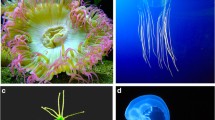Summary
-
1.
A radio-enzymatic technique was used to assay the catecholamines, dopamine (DA), noradrenaline (NA) and adrenaline (A) in relatively small samples of dogfish blood, obtained from an indwelling cannula. The removal of a 2 ml sample of blood has no appreciable effect on the levels of circulating catecholamines in the dogfish. Thus, the three amines could be measured before and after a particular experimental treatment by removing 2 ml of blood before and 7–8 ml of blood after the treatment.
-
2.
In resting, normoxic dogfish at 15°C, the mean (±S.E.) levels of the three amines in the plasma were: DA, 6.0±1.2 pmol ml−1; A, 25.6±6.5 pmol ml−1; NA, 32.1±19.3 pmol ml−1. Following exposure to an inspired oxygen tension of approximately 35 mmHg for 1.5 h there was an increase in all three catecholamines to: DA, 11.3±1.4 pmol ml−1; A, 284.4±86.2 pmol ml−1; NA, 446.5±117.6 pmol ml−1. These increases are discussed in terms of the known effects of the substances on the isolated heart and branchial arteries of elasmobranchs.
Similar content being viewed by others
References
Axelrod, J., Tomchick, R.: Enzymatic O-methylation of epinephrine and other catechols. J. Biol. Chem.233, 702–705 (1958)
Bailey, N.T.J.: Statistical methods in biology. London: The English Universities Press Ltd. 1959
Burnstock, G.: Evolution of the autonomic innervation of visceral and cardiovascular systems in vertebrates. Pharmacol. Rev.21, 247–324 (1969)
Butler, P.J., Taylor, E.W.: Response of the dogfish (Scyliorhinus canicula L.) to slowly induced and rapidly induced hypoxia. Comp. Biochem. Physiol.39 A, 307–323 (1971)
Butler, P.J., Taylor, E.W.: The effect of progressive hypoxia on respiration in the dogfish (Scyliorhinus canicula) at different seasonal temperatures. J. Exp. Biol.63, 117–139 (1975)
Capra, M.F., Satchell, G.: Adrenergic and cholinergic responses of the isolated saline-perfused heart of the elasmobranch fishSqualus acanthias. Gen. Pharmacol8, 59–65 (1977a)
Capra, M.F., Satchell, G.: The adrenergic responses of isolated saline-perfused prebranchial arteries and gills of the elasmobranchSqualus acanthias. Gen. Pharmacol.8, 67–71 (1977b)
Capra, M.F., Satchell, G.: The differential haemodynamic responses of the elasmobranchSqualus acanthias to the naturally occuring catecholamines adrenaline and noradrenaline. Comp. Biochem. Physiol.58 C, 41–48 (1977c)
Coyle, J.T., Henry, D.: Catecholamines in fetal and newborn rat brain. J. Neurochem.21, 61–67 (1973)
Cuello, A.C., Hiley, R., Iverson, L.L.: Use of catechol-O-methyl-transferase for the enzyme radiochemical assay of dopamine. J. Neurochem.21, 1337–1340 (1973)
Davies, D.T., Rankin, J.C.: Adrenergic receptors and vascular responses to catecholamines of perfused dogfish gills. Comp. Gen. Pharmacol.4, 139–147 (1973)
Euler, U.S. v., Fänge, R.: Catecholamines in nerves and organs ofMyxine glutinosa, Squalus acanthias andGadus callarias. Gen. Comp. Endocrinol.1, 191–194 (1961)
Fry, J.P., House, C.R., Sharman, D.F.: An analysis of the catecholamine content of the salivary gland of the cockroach. Br. J. Pharmacol.51, 116P (1974)
Gannon, B.J., Campbell, G.D., Satchell, G.H.: Monoamine storage in relation to cardiac regulation in the Port Jackson SharkHeterodontus portusjacksoni. Z. Zellforsch.131, 437–450 (1972)
Grant, W.D., Hendler, F.J., Banks, P.M.: Studies of blood-sugar regulation in the little skate,Raja erinacea. Physiol. Zool.42, 231–247 (1969)
Keys, A., Bateman, J.B.: Branchial responses to adrenaline and pitressin in the cel. Biol. Bull. Mar. Biol. Lab. Woods Hole,63, 327–336 (1932)
Martin, I.L., Baker, G.B., Fleetwood-Walker, S.M.: Modification of the radioenzymatic assay for the catecholamines. Biochem. Pharmacol. (in press) (1978)
Mazeaud, M.: Influence de stress sur les teneurs en catécholamines du plasma et des corps axillaires chez un Sélacian, la Roussette (Scyliorhinus canicula L.). C.r. Séanc. Soc. Biol.163, 2262–2266 (1969)
Nakono, T., Tomlinson, N.: Catecholamine and carbohydrate concentrations in rainbow trout (Salmo gairdneri) in relation to physical disturbance. J. Fish. Res. Bd. Canada24, 1701–1715 (1967)
Nilsson, S., Holmgren, S., Grove, D.J.: Effects of drugs and nerve stimulation on the spleen and arteries of two species of dogfish,Scyliorhinus canicula andSqualus acanthias. Acta Physiol. Scand.95, 219–230 (1975)
Östlund, E., Fänge, R.: Vasodilation by adrenaline and noradrenaline, and the effects of some other substances of perfused fish gills. Comp. Biochem. Physiol.5, 307–309 (1962)
Pendleton, P.G., Setler, P.E.: Peripheral cardiovascular dopamine receptors. Gen. Pharmacol.8, 1–5 (1977)
Satchell, G.H.: Intrinsic vasomotion in the dogfish gill. J. Exp. Biol.39, 503–512 (1962)
Satchell, G.H.: Circulation in Fishes. London: Cambridge University Press 1971
Shepherd, D.M., West, G.B., Erspamer, V.: Chromaffin bodies of various species of dogfish. Nature172, 509 (1953)
Short, S., Butler, P.J., Taylor, E.W.: The relative importance of nervous, humoral and intrinsic mechanisms in the regulation of heart rate and stroke volume in the dogfish (Scyliorhinus canicula L.). J. Exp. Biol.70, 77–92 (1977)
Wahlquist, I., Nilsson, S.: The role of sympathetic fibres and circulating catecholamines in controlling the blood pressure and heart rate in the cod,Gadus morrhua. Comp. Biochem. Physiol.57C, 65–67 (1977)
Weise, V.K., Kopin, I.J.: Assay of catecholamines in human plasma: studies of a single isotope radio enzymatic procedure. Life Sciences19, 1673–1686 (1976)
Wood, C.M.: A criticial examination of the physical and adrenergic factors affecting blood flow through the gills of the rainbow trout. J. Exp. Biol.70, 241–265 (1974)
Young, J.Z.: The autonomic nervous system of selachians. Q. Jl. Microsc. Sci.75, 571–624 (1933)
Author information
Authors and Affiliations
Additional information
This work was supported by the Science Research Council
Rights and permissions
About this article
Cite this article
Butler, P.J., Taylor, E.W., Capra, M.F. et al. The effect of hypoxia on the levels of circulating catecholamines in the dogfishScyliorhinus canicula . J Comp Physiol B 127, 325–330 (1978). https://doi.org/10.1007/BF00738416
Accepted:
Issue Date:
DOI: https://doi.org/10.1007/BF00738416




